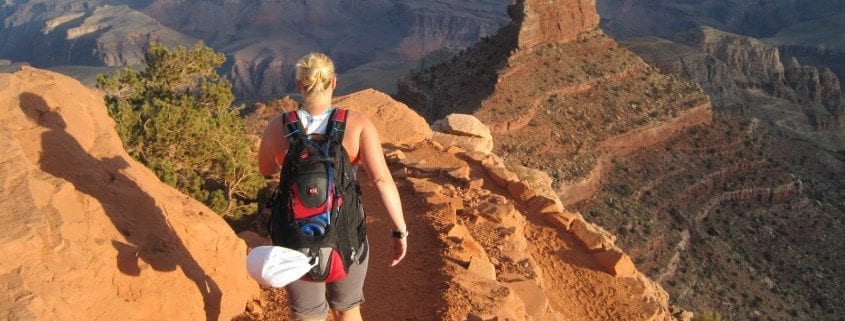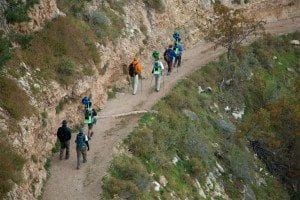Hiker Mistakes that Can Ruin your Grand Canyon Vacation… or Worse
Updated Feb 24, 2020
The Grand Canyon is visited by thousands of tourists every year because of the beauty of the natural wonder. However, the Grand Canyon also poses risks despite numerous safety measures. The Arizona Daily Sun reported that 55 people have fallen into the canyon. However, dying from dehydration or heat exhaustion is much more likely. The chance of falling into the Grand Canyon is about one in 400,000.
Falls, heat stroke, dehydration: Each year, hikers die on their Grand Canyon trip because they underestimate the dangers of the wilderness.
Canyon experts Michael Ghiglieri and Tom Myers (a biologist and a medical doctor) documented these tragedies in their book Over the Edge – Death in Grand Canyon. The authors show that most of the deaths, whether of experienced adventurers, tourists, or prospectors, occurred when people failed to pay attention to warning signs or did not use common sense. With the summer season approaching, the most dangerous time for Grand Canyon hiking is about to begin.
Often times when you take a few steps along the Bright Angel Trail at the Grand Canyon you can see them: people trudging down the well-trodden path to get an impression of the interior of the famous gorge with nothing more than flip flops and spaghetti straps shirts. However, the same hikers later realize that the beginning of the hike is the easy part – the hard part is getting back up, which takes about twice the time.
Nearly five million people visit the park annually; most just take a look from the south rim. However, approximately 40,000 venture out on the trails that are among the most spectacular on the planet. More than 20,000 people a year experience the Canyon by boat on the wild Colorado River between Glen Dam in Page and Lake Mead near Las Vegas.
Here are the most common mistakes hikers make:
1. They don’t bring enough water.
During summer, temperatures inside the Grand Canyon often reach more than 110 degrees Fahrenheit. Each hiker should carry and drink about a gallon (4 liters) of water per day. Drink before you get thirsty, your body needs water to operate effectively. Carry your water bottle in your hand and drink small amounts often.
Note: Purified drinking water is only available at a few locations in the Grand Canyon along the Corridor trails. All pipelines in the Canyon are subject to break at any time of year, cutting off water supply. Always carry water with you.
2. They don’t bring enough food.
The situation is similar with food. Take enough supplies with you so you don’t go hungry. Hiking takes a lot out of you so extra calories are needed, especially at higher elevation. Bring items that include some type of protein like protein bars or mini prepackaged sausages, sweet items like cookies, salty items like pretzels or crackers, and some sort of trail mix.
3. They underestimate the wilderness and overestimate their own abilities.
In 2009, nine hikers lost their lives in the Grand Canyon. The Canyon is no Disneyland but rather a hostile landscape with temperatures reaching triple digits in the summer in the shade and below freezing temperatures in the winter. Rainstorm triggered torrential flash floods, the terrain off the beaten track, loose rocks and steep cliffs are challenges even for experienced hikers
4. They don’t wear comfortable hiking boots.
Appropriate footwear is the most important tool for a hiker, therefore, the shoes should fit perfectly. Whether you want sneakers or hiking boots, it‘s up to you. Overall, choose comfortable shoes that have traction and grip. Before you embark on your first hike, break them in. Wear them on walks or on your daily errands. Also, make sure to wear special hiking socks.
5. They don’t wear appropriate hiking clothes.
The weather can quickly change in the Grand Canyon, especially when you are hiking at various elevations. Generally, hiking clothes should offer protection from cold, wind, rain and heat while ensuring a pleasant body climate. Experienced hikers make sure that no water penetrates their clothing. Layers work best since you can add or subtract clothing as needed.
Hiking clothes should be comfortable so it’s best to purchase them a half size too big than too small. Pack additional protective clothing such as a jacket , rain jacket or a wind breaker. And don’t forget the sunscreen.
6.They overpack their backpacks.
Only carry the essentials for a one-day hike. Water, food, a small first aid kit, flashlight, camera, as well rain and sun protection should be included in your backpack, even a small towel can be useful. Look for a backpack with padded shoulder straps equipped with a system for back ventilation. Note that the mules can be booked to carry your backpack down to Phantom Ranch if you plan to stay there overnight or at Bright Angel Campground.
7. They don’t plan their hiking tours.
Enjoy nature in peace and without time pressure. The safest route to get from the South Rim to the Bright Angel Campground (and spend the night there) is the Bright Angel Trail. Many hikers prefer to descend the shorter South Kaibab Trail and then go back up the Bright Angel Trail. The South Kaibab Trail is shorter and steeper, has no water points and provides no shade. Along the Bright Angel trails are, however, several water stations at Indian Garden Campground and rest houses.
8. They don’t let others know of their travel plans.
The basic rules for a canyon hike are simple and are mentioned at the South Rim of the park everywhere: sun protection, clothing, sturdy shoes, one gallon of water per day, a map, plenty of salty food and a flashlight. It is also recommended not to go alone and have someone informed about your destination and planned duration of the hike, so that recovery is possible in an emergency. One nice thing about the hikers that stay at Phantom Ranch is that they check in beforehand at the top of the Grand Canyon South Rim at the Bright Angel Transportation Desk at Bright Angel Lodge so people can know about their plans.




 Shutterstock
Shutterstock